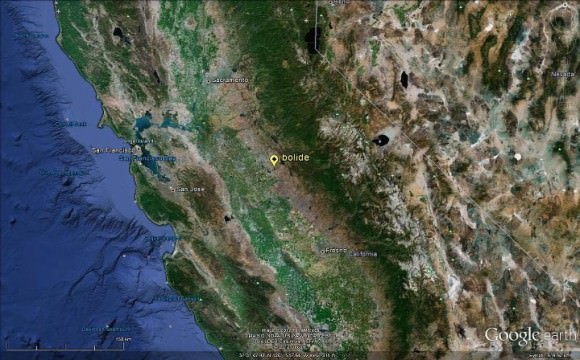A daytime fireball over the skies of central/northern California on Sunday morning, April 22, 2012 caused a loud explosion and the event was also detected on several seismographs stations in the area. According to Bill Cooke, head of NASA’s Meteoroid Environments Office, the source of the blast was a meteoroid about the size of a minivan, weighing in at around 70 metric tons (154,300 pounds) and at the time of disintegration released energy equivalent to a 5-kiloton explosion.
For comparison, conventional bombs yield energy from less than 1 ton to 44 tons, and the approximate energy released when the Chicxulub impact caused the mass extinction 65 million years ago was estimated to be equal to 96 million megatons of TNT.
“This was a BIG event,” said Elizabeth Silber of the Meteor Group at the Western University in Ontario, Canada.
“Most meteors you see in the night’s sky are the size of tiny stones or even grains of sand and their trail lasts all of a second or two,” said Don Yeomans of NASA’s Near-Earth Object Program Office at the Jet Propulsion Laboratory in Pasadena, Calif. “Fireballs you can see relatively easily in the daytime and are many times that size – anywhere from a baseball-sized object to something as big as a minivan.”
“Most meteors you see in the night’s sky are the size of tiny stones or even grains of sand and their trail lasts all of a second or two,” said Don Yeomans of NASA’s Near-Earth Object Program Office at the Jet Propulsion Laboratory in Pasadena, Calif. “Fireballs you can see relatively easily in the daytime and are many times that size – anywhere from a baseball-sized object to something as big as a minivan.”
Silber estimates the location of its explosion in the upper atmosphere above California’s Central Valley. It is not known yet if any pieces of the space rock survived to land as meteorites, but the entire object was likely vaporized before hitting the ground. However, you can bet there are people out looking. (Silber said on the Meteorobs newsgroup that based on infrasonic data the approximate source coordinates are 37.6N, 120.5W).
Descriptions of the fireball range from a “silver flash” to like a “green glittering sparkler,” and one person said their sighting of the object was followed 4-5 minutes later by a loud sonic boom.
Unfortunately, since the huge fireball occurred during the day, all of NASA’s meteor-seeking cameras were turned off, so images of the event are sparse. You can see some at news station KTVN’s website.
This type of fireball is quite rare, and visual observations of them are even more rare. “An event of this size might happen about once a year,” said Yeomans. “But most of them occur over the ocean or an uninhabited area, so getting to see one is something special.”
That the fireball occurred during the Lyrid meteor shower is probably a coincidence, most experts are saying, as meteor shower meteors are generally small bits space dust that don’t produce large fireballs. However, another large fireball also occurred on April 20 in Brazil. See more information about that bolide here.
Source: Universe Today

No hay comentarios:
Publicar un comentario